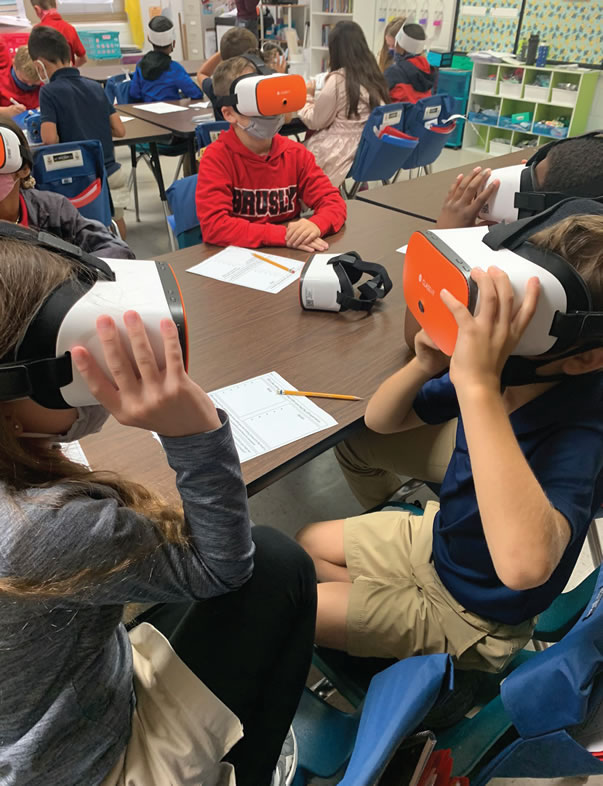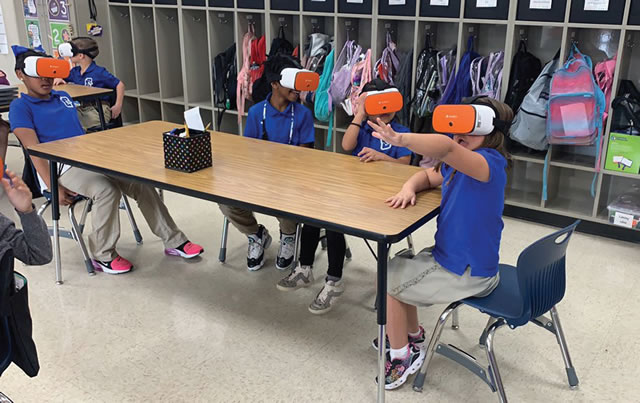A Picture Is Worth More Than A Thousand Words
Imagine being transported to the deepest regions
of space, or the nucleus of a cell, or the interior of a human
heart. Imagine visiting the Great Wall of China, or Victorian-era
London, or the Wright Brothers’ first flight at Kitty Hawk in 1903.
Reading about them is one thing; seeing them all around you is
something else entirely. One educational virtual reality solution
from Avantis Systems aims to provide students with experiences
that they—or anyone—would never be able to see in real life.

PHOTO COURTESY OF WEST BATON ROUGE PARISH SCHOOLS
ClassVR launched in January 2017 and provides thousands of
educational VR resources and structured lesson plans that align
with elementary-, middle- and high-school curricula nationwide.
Resources are available in subjects from art to biology to chemistry
to language arts to history—and more. Teachers and students
can also upload their own 360-degree images and videos to create
their own VR experiences. These immersive, engaging experiences
help students visualize the concept at hand, adding a layer of
personal experience to their understanding of the subject matter.
West Baton Rouge (WBR) Parish Schools in Port Allen, La.,
began the process of adopting ClassVR in spring 2021. WBR
serves as a Head Start through twelfth-grade district with about
4,200 students and ten schools: five elementary, three middle
and two high. The district’s ClassVR program is run by Dr.
Tammy Seneca, Supervisor of Information Systems and Educational
Technology, and Stephanie Thompson, District Technology
Facilitator and Professional Developer.
“The kids really get…it kinda breaks down the walls of the
classroom, so kids who don’t necessarily have a lot of travel experience
or, for example, if they’re reading a book about the
Great Wall of China, you know, nine times out of ten, they haven’t seen the Great Wall of China. But they get to experience
it through the ClassVR,” said Seneca. “And so, it really kind of
gives them that almost one-to-one kind of feel of what it would
be like if they were actually there. I think that’s been the most
positive feedback.”
“The teachers are just really excited because the students are
so excited,” added Thompson. “They’re just oohing and aahing
and ‘Woah, oh my goodness,’ and it just really provides a little
bit more concrete examples of what they’re learning about that they don’t have access to.”
One fundamental feature of ClassVR
is the way that its content integrates with
teachers’ existing lesson plans and curricula.
“Our department…for example,
when Stephanie’s working with teachers,
the first question is, ‘What are you teaching?’
We’re always trying to connect back
to the curriculum,” Seneca said.
“The way it works is the teacher on
the front end, when they’re doing their
lessons, they decide what kind of scenes,
what they’re looking for, and they create
sort of this playlist,” Thompson said.
“And they have a playlist ready to go to
show…they flip the kids through different
scenes. The students don’t really get
to see ahead of time what they’re going
to see because the teacher’s controlling
it. And so, there’s not a lot of classroom
disruption because of that, and it flows
pretty easily, with the teacher sort of in
control of what students are going to experience
in their curriculum.”
In addition to the existing VR scenes
and environments, teachers can also use
360-degree cameras to create their own.
One high-school environmental science
teacher from West Baton Rouge created a
rendering of nearby Bluebonnet Swamp.
Another group used them to capture images
of a variety of plants, insects and
birds for identification in class. Finally, one
middle school in the district recreated the
school itself as an introduction to elementary
students coming into the middle school.
“They kind of do a walkthrough tour
of, ‘This is what the school’s going to
look like. This is how you go up the staircase,
this is where you go down this hall
for eighth grade, this hallway for seventh
grade, this is where the cafeteria is,’” said
Thompson. “They’re approaching it more
from a hands-on…creating the video, editing
the video, they’re adding additional
images and text, things like that. So,
they’re spending a good amount of time
video editing, and then they’re going to
load it into ClassVR so they can share it
with the elementary kids.”
At West Baton Rouge, all the ClassVR
kits are housed in the Technology Department,
and individual teachers check
them out on a lesson-by-lesson basis.
Teachers receive training as the district
tech staff visits individual schools’ Professional
Learning Communities (PLCs)
as well as during summer professional
development opportunities and technology
challenges.

PHOTO COURTESY OF WEST BATON ROUGE PARISH SCHOOLS
The district has 128 ClassVR headsets,
16 kits of 8 devices each. Each device
has its own label (e.g., “Faithful Alpaca”)
for tracking purposes. Teachers checking
out a kit for the first time receive an invitation
to join the district’s license in the
ClassVR portal. They also receive video
instructions on how to search for and create
playlists. The district uses its in-house
mail system for delivery and pickup to
individual schools. Seneca and Thompson
both noted that, once teachers reach
a certain comfort level with the devices,
they’ve been training each other and recommending
different uses or experiences.
“What we’re also seeing is that the
teacher that comes to training, that likes ClassVR, the teacher next to her sees (or he sees) this happening,
and they’ve been able to train each other,” said Seneca. “So,
they’ll just transfer the devices the next day over to the other
classroom, and they’re so easy to use that it’s just that quick.”
“I find a lot of times, I’ll just show one teacher in the group,
like a group of third-grade teachers, and they’re all doing the
same thing. So once one teacher uses it, she shows the other ones:
‘Hey, y’all gotta do this.’ And then they all are now on board. And
so now I’ve got, instead of one teacher who knows, I’ve got five
teachers who know how to use it in that little pocket,” Thompson
said. “So really, it just kind of grows and spreads like wildfire.”
ClassVR also extends beyond traditional classroom subjects
into CTE and wellness. Local companies have approached the district
to sponsor advanced VR opportunities in high schools after
seeing how they’re used. “We’re working on that as well, to try to
get some more, for example, Career Tech Ed, where they do pipe
fitting. And they actually learn how to be a pipe fitter with the
ClassVR and that kind of stuff,” Seneca said. “And some of that
came from me having conversations with this local partner about
what we’re doing with ClassVR, and showing them how we’re
starting with the younger kids and giving them experiences.”
Experiences are available related to STEM and CTE topics
and careers like helicopter pilots, miners, motion capture specialists,
surgical training, car factory tours, Tesla factories, gas
turbine factories, aircraft carriers, submarines, oil rigs, space stations,
refrigerators, washing machines, dishwashers and more.
Even elementary-school guidance counselors have adopted
the technology to help with social and emotional learning (SEL).
The experience can help students with autism or behavior disorders
with regard to calming and cooling off, life skills, social
situations, sensory experiences and a wide variety of others.
However, in the district at large, the most popular environments
are the ones that give students
a glimpse of the world beyond their
own experiences. “Space is popular.
Habitats have been popular,” said
Seneca.
“I feel like they’re really using it
with their English Language Arts,
seems to be the subject area most
used,” said Thompson. “Because every
time they go to a new book that
they’re going to study, they check
them out in order to give them some
background knowledge or more information
about what they’re going
to be reading. So that seems to be
the hottest area, is in the ELA classroom. Where, you would
think, the history teachers or the science teachers, but they really
check it out so much for the ELA. I mean, they check them
out in all areas, but I’ll say our hottest spot is through our reading
curriculum.”
Seneca added, “We’ve even had art teachers check them out
for their art students to go visit the Sistine Chapel and places
like that. We have a great picture of the high school kids lying
on the floor with them, looking up like the artist did.”
Sometimes, though, teachers use the ClassVR technology to
give students a bit of old-fashioned fun.
“One of the ones that probably got the most publicity, and
in our school district it made it take off, was we did one around
Christmastime about Santa Claus,” said Thompson. “The PreK
teachers wanted something about the North Pole, and about
Santa Claus, and reindeer. And so,
we were able to find some great videos.
One of them was where it’s taken
from the point of view where the
student is sitting next to Santa Claus.
So, like, if they turned their heads to
the left, Santa Claus is sitting there,
and in front of them are the reindeer.
And then the sleigh takes off, and as
they’re taking off, they see London
beneath them, the lights and the
city beneath them. And those students—”
“Those are some great pictures,”
chuckled Seneca.
“And it was just great to be in the room with the students
because they were just screaming like they’re on a ride with Santa
Claus, and it was just so real for them,” said Thompson. “That’s
the one that, I think, pushed ClassVR into so many classrooms.
Because once one teacher did it, everybody wanted to do it.”
This article originally appeared in the Summer 2022 issue of Spaces4Learning.